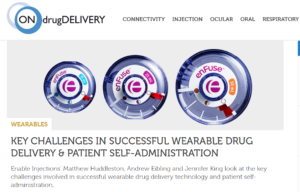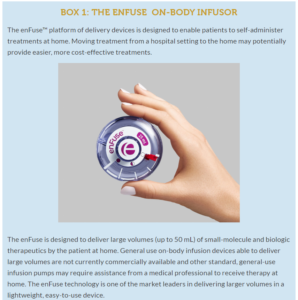
Key Challenges in Successful Wearable Drug Delivery and Patient Self-Administration
The September 2019 issue of OnDrugDelivery features a new article, Key Challenges in Successful Wearable Drug Delivery and Patient Self-Administration. In the article, Enable Injections’ Matthew Huddleston, Andrew Eibling and Jennifer King look at the key challenges involved in successful wearable drug delivery technology and patient self-administration.
Read an excerpt with a link to the published article, below:
Key Challenges in Successful Wearable Drug Delivery and Patient Self-Administration 
Cutting-edge biologic therapies often require patients to receive treatment through frequent IV infusions at a hospital or infusion clinic. But what would happen if those same biologics could be given by the patient through a simple through-the-skin infusion at home? Why has there not been a greater push for wearable technology that allows people to self-administer infused medicines at home?
Armed with game-changing technology which makes this a possibility, Enable Injections’ goal is to reduce the treatment burden on people living with a wide-range of conditions and put control back into the hands of the patient.
The world is ready for the possibility. US Healthcare costs are increasing at a rate of 3-4% per year1. Evidence shows a reduction in the overall cost when therapy is administered in the home compared to a doctor’s office or clinic2. Patients are ready for it, too. Evidence shows improved compliance and adherence to medications when patients can complete the therapy at home compared to administering infusion in the physician’s office or clinic3. 
Up to this point, technology has been the limiting factor. Biologic therapies often start with intravenous (IV) infusion and require large volumes for efficacy. Transition to subcutaneous delivery may even require higher volumes due to bioavailability. These large volumes are not suitable for administration via auto-injectors and prefilled syringes. Large infusion pumps are available for subcutaneous delivery in the home, but they are complex, and often require in-home infusion services for administration.
There exists the need for a cost-effective, simple-to-use, large volume, subcutaneous, self-administration infusion system which creates real value for both the pharmaceutical companies and the patients. With the right technology, the market environment is primed to transition.
Click here to read more about Pharma and Patient Challenges in the published article at the OnDrugDelivery website.
